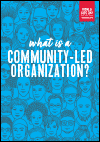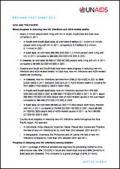What's New
Displaying results 961 - 970 of 4911

Resource | Publications,
Experiences across UNFPA have shown that GBV practitioners have faced challenges in determining when and how to use these tools and how to adapt different approaches to diverse contexts. This brief guidance note defines the distinct objectives of and links between these two resources. It supports GBV practitioners in navigating the use of both across a range of contexts.

Resource | Infographics,
Communities are the best way to reach, communities are the torchbearers of human rights, communities have the trust of the people they serve, investing in communities is value for money, communities are leaders in innovation.

Resource | Infographics,
In 2018: 54% of new HIV infections were among key populations and their sexual partners, 40% decrease in new HIV infections since the peak in 1997, 37.9 million people living with HIV in the world, 1 700 000 children living with HIV (under 15 years).

Resource | Publications,
Together, the 28 countries account for 75% of all new HIV infections globally—1.2 million of the 1.7 million new HIV infections among adults in 2018. The report, Implementation of the HIV prevention 2020 road map, shows that among the coalition countries new HIV infections among adults declined on average by 17% since 2010, slightly higher than the global decline of 13%, but far short of the 60% decline needed in 2018 to meet global HIV prevention targets.

Resource | Publications,
This flagship report for ICPD25 examines the interplay between sustainable development, rights and changing demography and how this impacts the ability of governments, civil society and other stakeholders to achieve the vision set forth in Cairo and reaffirmed at the Midterm Review of the Asia Pacific Ministerial Declaration on Population and Development.

Resource | Publications,
This review utilizes national-level quantitative data to provide a comprehensive profile of how gender inequality impacts girls and boys, in low and middle-income countries in East Asia and Southeast Asia. This report describes the effects of gender inequality in the domains of health, education and transition to employment, protection and safe environment. The review identifies key data and knowledge gaps relating to gender inequality for children and adolescents, provides recommendations for priority gender indicators, and calls for investments in data collection, additional research and action to address the key drivers of gender inequality in the region.

Resource | Publications,
This review utilizes national-level quantitative data to provide a comprehensive profile of how gender inequality impacts girls and boys, in low and middle income countries in the Pacific. This report describes the effects of gender inequality in the domains of health, education and transition to employment, protection and safe environment. The review identifies key data and knowledge gaps relating to gender inequality for children and adolescents, provides recommendations for priority gender indicators, and calls for investments in data collection, additional research and action to address the key drivers of gender inequality in the region.

Resource | Publications,
Gender Counts, a new, first-of-its-kind review, utilizes quantitative data to provide a comprehensive profile of how gender inequality impacts girls and boys, in the low and middle-income countries in Asia-Pacific. This report focuses on South Asia. The reports describe the effects of gender inequality in the domains of health, education and transition to employment, protection and safe environment. The review identifies data gaps for children and adolescents; provides recommendations for priority gender indicators; and calls for investments in data collection, research and action, to better understand and address the key drivers of gender inequality in the region.

Resource | Publications,
Community-led organizations are led by the people who they serve and are primarily accountable to them. In the AIDS response, this includes organizations by and for people living with HIV or tuberculosis and organizations by and for people affected by HIV, including gay men and other men who have sex with men, people who use drugs, prisoners, sex workers, transgender people, women and young people.






